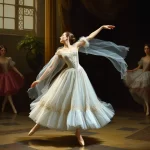Ballet: La Fille de marbre (Cesare Pugni, 1847)

Introduction
La Fille de marbre is a ballet composed by Cesare Pugni, with choreography by Arthur Saint-Léon. Premiered on October 20, 1847, at the Paris Opera, this ballet is a quintessential example of the Romantic era’s fascination with the supernatural and the ethereal. The ballet tells the story of a young sculptor who falls in love with a statue he has created, which magically comes to life. This narrative explores themes of love, art, and the boundary between reality and fantasy.
Historical Background
Creation and Development
The mid-19th century was a period of significant transformation in the arts, marked by the Romantic movement’s emphasis on emotion, nature, and the supernatural. La Fille de marbre was created in this context, drawing inspiration from the era’s literary and artistic trends. The ballet was inspired by the myth of Pygmalion, a sculptor who falls in love with a statue he has carved, which then comes to life. This myth was a popular subject in Romantic literature and art, symbolizing the power of love and the artist’s creative genius.
Arthur Saint-Léon, the choreographer, collaborated closely with Cesare Pugni, the composer, to bring this story to life through dance and music. Saint-Léon was known for his innovative choreography, which often incorporated elements of folk dance and mime, while Pugni was celebrated for his ability to create evocative and emotionally resonant scores.
Premiere and Reception
La Fille de marbre premiered on October 20, 1847, at the Paris Opera. The initial reception was overwhelmingly positive, with critics and audiences alike praising the ballet’s innovative choreography, compelling music, and enchanting story. The ballet quickly became a staple of the Paris Opera’s repertoire and was performed frequently throughout the 19th century.
Notable early performances included revivals in major European cities such as London and St. Petersburg, where the ballet continued to captivate audiences with its blend of romance and fantasy.
Synopsis of the Ballet
Act I Summary
The ballet opens in the studio of a young sculptor named Pierre. He is working on a statue of a beautiful woman, which he has named “La Fille de marbre.” Pierre is deeply in love with his creation, and his obsession with the statue begins to affect his relationships with those around him, including his fiancée, Thérèse. As Pierre works late into the night, a mysterious figure appears and brings the statue to life. The act ends with Pierre in awe as he realizes that his beloved statue has come to life.
Act II Summary
In the second act, the now-living statue, named Marguerite, explores the world outside the studio. She experiences the joys and challenges of human life, including love, jealousy, and betrayal. Pierre is torn between his love for Marguerite and his loyalty to Thérèse. The tension between the characters builds as Marguerite’s presence disrupts the lives of those around her. The act culminates in a dramatic confrontation between Pierre, Thérèse, and Marguerite.
Act III Summary
The final act sees the resolution of the central conflict. Marguerite, realizing the turmoil her existence has caused, decides to return to her original form as a statue. In a poignant and emotional scene, she bids farewell to Pierre and Thérèse before transforming back into marble. The ballet concludes with Pierre and Thérèse reconciling, their love strengthened by the trials they have endured.
Finale
The conclusion of La Fille de marbre is both bittersweet and uplifting. Marguerite’s return to her statue form symbolizes the ephemeral nature of beauty and the power of love to transcend even the most extraordinary circumstances. The ballet’s finale leaves audiences with a sense of wonder and reflection on the themes of love, art, and the boundary between reality and fantasy.
Musical Composition
Composer’s Role
Cesare Pugni, an Italian composer known for his prolific output of ballet music, played a crucial role in the creation of La Fille de marbre. Pugni’s score is characterized by its lyrical melodies, rich harmonies, and dramatic orchestration, which perfectly complement Saint-Léon’s choreography. Notable pieces within the score include the enchanting waltz that accompanies Marguerite’s first dance as a living being and the poignant adagio during the ballet’s emotional climax.
Musical Themes and Motifs
Pugni’s score for La Fille de marbre features several recurring musical themes and motifs that enhance the narrative and emotional impact of the ballet. One of the most prominent motifs is the “Marguerite Theme,” a delicate and ethereal melody that represents the statue’s transformation into a living being. This theme recurs throughout the ballet, underscoring key moments in Marguerite’s journey and her interactions with Pierre and Thérèse.
Another significant motif is the “Love Theme,” a sweeping and passionate melody that symbolizes the love between Pierre and Thérèse. This theme is woven into the score at various points, highlighting the emotional stakes of the characters’ relationships.
Famous Recordings and Performances
While there are few recordings of the complete score of La Fille de marbre, several excerpts have been performed and recorded by renowned orchestras and ballet companies. Notable performances include those by the Bolshoi Ballet and the Paris Opera Ballet, both of which have brought Pugni’s music to life with their exceptional interpretations.
Choreography and Dance
Choreographer’s Vision
Arthur Saint-Léon was known for his innovative and expressive choreography, which often incorporated elements of folk dance and mime. In La Fille de marbre, Saint-Léon sought to create a ballet that blended classical technique with dramatic storytelling. His choreography for the ballet is characterized by its fluidity, grace, and emotional depth, capturing the essence of the Romantic era’s fascination with the supernatural and the ethereal.
Signature Dance Numbers
One of the most iconic dance numbers in La Fille de marbre is the Pas de Deux between Pierre and Marguerite in Act II. This dance showcases the technical prowess and emotional expressiveness of the lead dancers, as they navigate the complexities of their characters’ relationship. Another notable scene is Marguerite’s solo dance upon first coming to life, which captures her wonder and curiosity as she explores the world around her.
Notable Interpretations
Over the years, different productions of La Fille de marbre have interpreted Saint-Léon’s choreography in various ways. Some productions have emphasized the ballet’s Romantic elements, focusing on the ethereal and otherworldly aspects of the story. Others have highlighted the dramatic and emotional conflicts between the characters, bringing a more contemporary sensibility to the choreography. Notable interpretations include those by the Paris Opera Ballet and the Bolshoi Ballet, both of which have brought their unique artistic visions to the ballet.
Characters and Roles
Main Characters
- Pierre: A young sculptor who falls in love with his creation, Marguerite. Pierre is a passionate and dedicated artist, whose obsession with his work leads to emotional turmoil.
- Marguerite: The statue created by Pierre, who magically comes to life. Marguerite is curious and innocent, experiencing the joys and challenges of human life for the first time.
- Thérèse: Pierre’s fiancée, who struggles with her feelings of jealousy and betrayal as Pierre becomes increasingly obsessed with Marguerite.
Supporting Characters
- The Mysterious Figure: A supernatural being who brings Marguerite to life. This character serves as a catalyst for the events of the ballet.
- Friends and Villagers: Various secondary characters who interact with Pierre, Marguerite, and Thérèse, adding depth and context to the story.
Famous Dancers
Over the years, many renowned dancers have portrayed the lead roles in La Fille de marbre. Notable performers include Carlotta Grisi, who originated the role of Marguerite, and Lucien Petipa, who was the first to dance the role of Pierre. In more recent times, dancers such as Svetlana Zakharova and Roberto Bolle have brought their exceptional talents to these iconic roles.
Cultural and Artistic Impact
Influence on Ballet and Dance
La Fille de marbre has had a significant influence on the development of ballet as an art form. Its innovative choreography and compelling narrative have inspired countless choreographers and dancers, contributing to the evolution of ballet technique and storytelling. The ballet’s blend of classical and dramatic elements has also paved the way for future works that explore similar themes of love, art, and the supernatural.
Cultural Significance
The ballet’s themes of love, art, and the boundary between reality and fantasy have resonated with audiences for generations. La Fille de marbre has been referenced in literature, theater, and other forms of art, reflecting its enduring cultural significance. The story’s exploration of the artist’s creative process and the power of love continues to captivate audiences and inspire new interpretations.
Legacy and Revivals
La Fille de marbre has been revived numerous times since its premiere, with major productions by companies such as the Paris Opera Ballet and the Bolshoi Ballet. These revivals have brought new life to the ballet, showcasing its timeless appeal and artistic significance. Modern adaptations have also explored different aspects of the story, highlighting its relevance to contemporary audiences.
Iconic Productions
Historic Productions
One of the most famous historical productions of La Fille de marbre was the original 1847 premiere at the Paris Opera, featuring Carlotta Grisi and Lucien Petipa in the lead roles. This production set the standard for future performances, with its innovative choreography and compelling storytelling. Other notable historical productions include revivals in London and St. Petersburg, which helped to establish the ballet’s international reputation.
Contemporary Productions
Recent productions of La Fille de marbre have brought new interpretations and artistic visions to the ballet. Companies such as the Paris Opera Ballet and the Bolshoi Ballet have continued to perform the ballet, incorporating modern techniques and sensibilities while staying true to the original spirit of the work. These contemporary productions have introduced the ballet to new audiences, ensuring its continued relevance and popularity.
Production Design
The set, costume, and lighting design of La Fille de marbre have played a crucial role in bringing the story to life. Historical productions often featured elaborate sets that recreated Pierre’s studio and the magical transformation of Marguerite. Costumes were designed to reflect the characters’ personalities and the ballet’s Romantic themes, with flowing dresses and ethereal fabrics for Marguerite and more grounded, realistic attire for Pierre and Thérèse. Lighting design has also been used to enhance the ballet’s dramatic and emotional impact, with soft, dreamlike lighting for Marguerite’s scenes and more intense, focused lighting for moments of conflict and tension.
Critical Reception and Reviews
Initial Critical Response
At the time of its premiere, La Fille de marbre received widespread acclaim from critics and audiences alike. Reviewers praised the ballet’s innovative choreography, evocative music, and compelling narrative. The performances of Carlotta Grisi and Lucien Petipa were particularly lauded, with critics highlighting their technical skill and emotional expressiveness.
Modern Reviews
Contemporary critics continue to recognize the significance of La Fille de marbre in the history of ballet. Modern reviews often focus on the ballet’s timeless themes and its influence on subsequent works. Critics also appreciate the ballet’s ability to captivate audiences with its blend of classical technique and dramatic storytelling. Recent productions have been praised for their fresh interpretations and artistic innovation, ensuring that La Fille de marbre remains a beloved and relevant work in the world of dance.
Fun Facts and Trivia
Behind-the-Scenes Stories
One interesting anecdote from the original production of La Fille de marbre involves Carlotta Grisi, who played Marguerite. During one performance, a technical malfunction caused the mechanism that brought the statue to life to fail. Grisi, ever the professional, improvised her movements to create the illusion of transformation, earning applause from the audience for her quick thinking and creativity.
Notable Performers
In addition to Carlotta Grisi and Lucien Petipa, other famous dancers who have performed in La Fille de marbre include Anna Pavlova, who brought her unique grace and expressiveness to the role of Marguerite, and Rudolf Nureyev, whose powerful and emotive portrayal of Pierre captivated audiences.
Trivia
- Cesare Pugni: The composer of La Fille de marbre, Cesare Pugni, was one of the most prolific ballet composers of the 19th century, with over 300 ballets to his name.
- Arthur Saint-Léon: In addition to his work as a choreographer, Arthur Saint-Léon was also an accomplished violinist and composer, contributing to the musical landscape of his ballets.
- Mythical Inspiration: The story of La Fille de marbre is inspired by the ancient Greek myth of Pygmalion, which has been adapted into various forms of art, including George Bernard Shaw’s play “Pygmalion” and the musical “My Fair Lady.”
Conclusion
Summary of the Ballet’s Importance
La Fille de marbre is a significant work in the history of ballet, exemplifying the Romantic era’s fascination with the supernatural and the power of love. Its innovative choreography, evocative music, and compelling narrative have made it a beloved classic that continues to captivate audiences and inspire artists.
Final Thoughts
The enduring appeal of La Fille de marbre lies in its timeless themes and its ability to evoke deep emotions through dance and music. Whether experienced through a live performance or a recording, this ballet offers a glimpse into the magic of the Romantic era and the transformative power of art. For those who have not yet had the pleasure of experiencing La Fille de marbre, it is a work that is well worth seeking out, whether through a live performance or a recording of its beautiful score.
FAQ
What is the central theme of this ballet?
The central theme of La Fille de marbre is the transformative power of love and art, exploring the boundary between reality and fantasy.
Who are the main characters in this ballet?
The main characters are Pierre, a young sculptor; Marguerite, the statue who comes to life; and Thérèse, Pierre’s fiancée.
What is the most famous dance number in this ballet?
The Pas de Deux between Pierre and Marguerite in Act II is one of the most famous dance numbers in La Fille de marbre, showcasing the technical prowess and emotional expressiveness of the lead dancers.
How long does a typical performance of this ballet last?
A typical performance of La Fille de marbre lasts approximately two hours, including intermissions.
Are there any modern adaptations of this ballet?
Yes, there have been several modern adaptations and revivals of La Fille de marbre, with contemporary productions incorporating new interpretations and artistic innovations.
Why is this ballet considered important in the history of dance?
La Fille de marbre is considered important in the history of dance due to its innovative choreography, evocative music, and compelling narrative. It has influenced subsequent works and contributed to the evolution of ballet as an art form.





